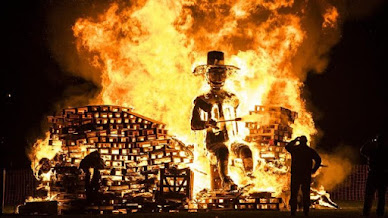Bonfire Night November 5th
I know I should have done this blog at the beginning of the month, but I had others already written, before I finished this one.
Remember, remember the Fifth of November,
The Gunpowder Treason and Plot,
I know of no reason
Why the Gunpowder Treason
Should ever be forgot.
Guy Fawkes, Guy Fawkes, t’was his intent
To blow up the King and Parli’ment.
Three-score barrels of powder below
To prove old England’s overthrow;
By God’s providence he was catch’d
With a dark lantern and burning match.
Holla boys, Holla boys, let the bells ring.
Holloa boys, holloa boys, God save the King!
And what should we do with him? Burn him!
Bonfire night, otherwise called Guy Fawkes Night, happens each year on 5 November. It denotes the commemoration of the disappointment of the Gunpowder Plot in 1605, in which 13 men including Guy Fawkes plotted to explode the House of Parliament in London. Yet, how have individuals denoted the event through history? Student of history Justin Pollard presents to you current realities...
Nobody was more enchanted by the thwarting of the Gunpowder Plot than James VI and I, who had barely abstained from turning into the primary lord to sit on a rocket-impelled privileged position. So he permitted huge fires to be lit to celebrate, if they were "with next to no risk or confusion".
A couple of months after the fact parliament passed the Observance of November fifth Act, successfully making the festival necessary. How you praised stayed dependent upon you (as long as you went to chapel). In Canterbury in 1607 they set off 106 pounds of black powder, giving a trace of what might be on the horizon.
By the late seventeenth century merriments were getting a shade raucous, as Londoners took to halting mentors and requesting brew cash, and all through the eighteenth century its prominence developed principally with the prospering metropolitan poor. Their kids found a better approach for making money on the evening, getting a 'penny for the Guy' – a representation consuming propensity began in 1625 when Charles I wedded a Catholic, rousing the immolation of ecclesiastical pictures.
The unruliness likewise proceeded. This 'custom' dates from at minimum the 1790s when 4 November is recorded as 'Naughtiness Night' – a period for tricks, for example, putting remedy on entryway handles and trading around garden doors. By the nineteenth century this was getting somewhat rowdy. In Guildford they consistently assaulted the officer's home and, in 1864, a cop was killed.
By March 1859 the public authority had revoked the 1606 Act. The Guildford crowd was controlled, and the brutality of the evening re-coordinated at the helpless old Guy. Not that he was essentially Guy Fawkes.
Since the time 1831, when an excited Exeter swarm consumed a likeness of their new cleric, new targets had been found for the huge fire. The kaiser and surprisingly a couple of suffragettes ended up so treated.
Today the person is fit as a fiddle, in spite of the fact that it is as prone to be a picture of the leader as Guy Fawkes, getting the kind of barbecuing you don't get in parliament, however which Guy himself wished they had all got.




Comments
Post a Comment